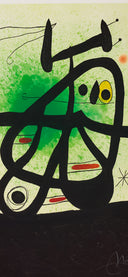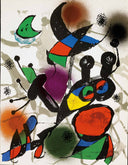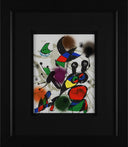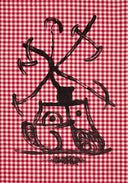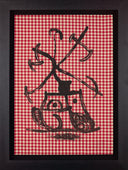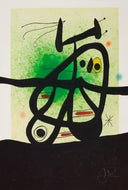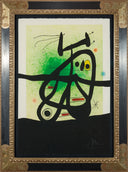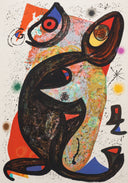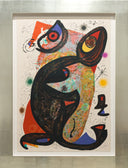About the Artist
Joan Miró (1893–1983) stands as one of the defining figures of 20th-century art, renowned for his ability to transform the visual language of modernism into a universe of symbols, signs, and poetic abstraction. Though celebrated for his paintings and monumental public commissions, Miró devoted much of his creative energy to the field of graphic art, where he achieved some of his most radical and enduring innovations. Today, these works resonate powerfully with collectors, reflecting both Miró’s timeless inventiveness and the contemporary market’s growing appreciation for fine prints as essential to an artist’s legacy.
From the 1930s onward, Miró immersed himself in the graphic arts, collaborating with leading master printers in Paris and Barcelona. He became one of the 20th century’s most prolific printmakers, producing over 2,000 etchings, lithographs, and woodcuts. Institutions such as the Fundació Joan Miró (Barcelona) and the Museum of Modern Art (New York) emphasize how Miró treated printmaking not as a secondary practice, but as a field of experimentation equal to painting and sculpture.
In Miró’s hands, the printed surface became a space of freedom: exploding with playful biomorphic forms, bold gestures, and vibrant colors. Works like the Barcelona Series (1939–1944), created during the turbulence of the Spanish Civil War, reveal his capacity to fuse political urgency with dreamlike imagery. Later series, such as Le Lézard aux plumes d’or (1971) and Gran Rupestres (1979), showcase his command of technical processes and his tireless inventiveness. These prints embody what Miró once described as his search for “a sort of pure poetry,” liberated from convention.
Unlike many modern painters who considered prints as reproductions, Miró approached etching, lithography, and woodcut as autonomous creative processes. By the 1930s he was already insisting that printmaking allowed him to “go further” than painting, pushing materials to yield unexpected textures, densities, and atmospheres. He elevated the medium’s status within modernism, helping establish printmaking as a legitimate, independent form of artistic expression.
Miró’s printmaking is marked by a spirit of technical audacity. He worked closely with master printers such as Fernand Mourlot in Paris and Enrique Tormo in Barcelona, using nontraditional tools and techniques:
- Sugar-lift aquatint: allowed him to achieve gestural, brush-like marks directly on the plate, blurring the line between drawing and print.
- Carborundum printmaking (pioneered in the 1960s): Miró became an early adopter of this abrasive technique, which produced richly textured surfaces and intense color saturation.
- Hybrid methods: He often combined etching, aquatint, and lithography in a single work, refusing to respect boundaries between processes.
In the global art market, Miró’s prints consistently attract discerning collectors, prized for both their historical significance and their aesthetic vitality. Auction houses and galleries alike recognize that his works on paper offer an entry point into the world of blue-chip collecting — works that are more intimate than his canvases yet equally representative of his genius. The steady demand reflects not only Miró’s place in art history, but also the growing recognition of the graphic arts as a central, rather than peripheral, component of modernism’s legacy.
Joan Miró’s prints bridge the poetic avant-garde of the 20th century with the aesthetic concerns of today’s collectors. In their vibrancy, rarity, and imaginative scope, they embody a timeless luxury.



